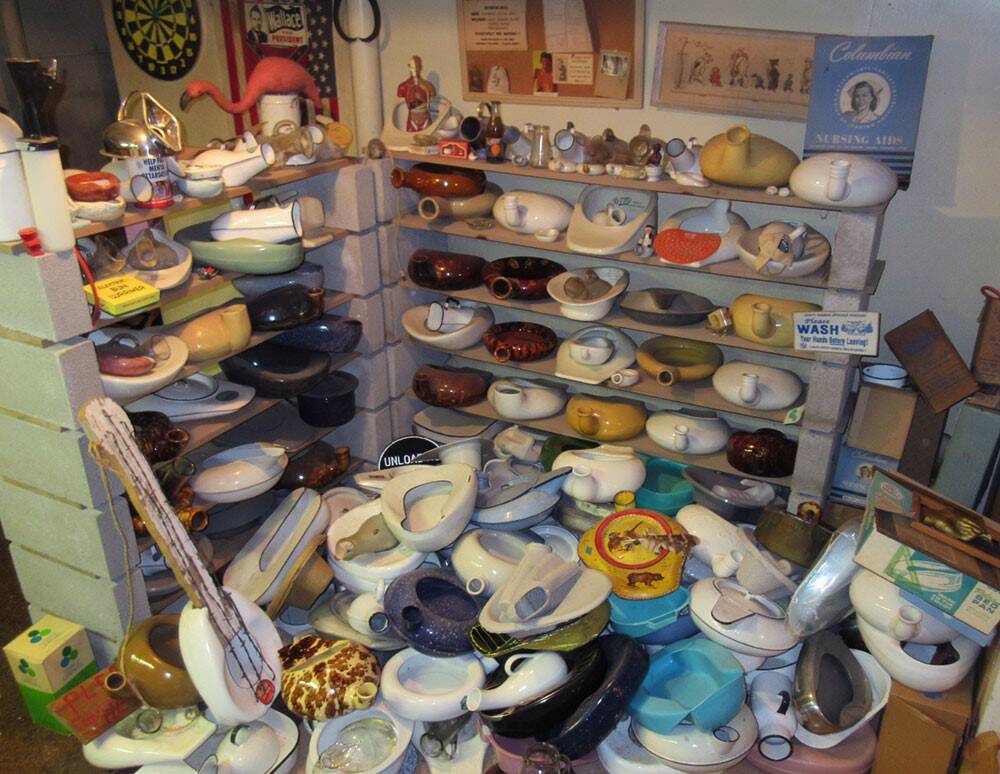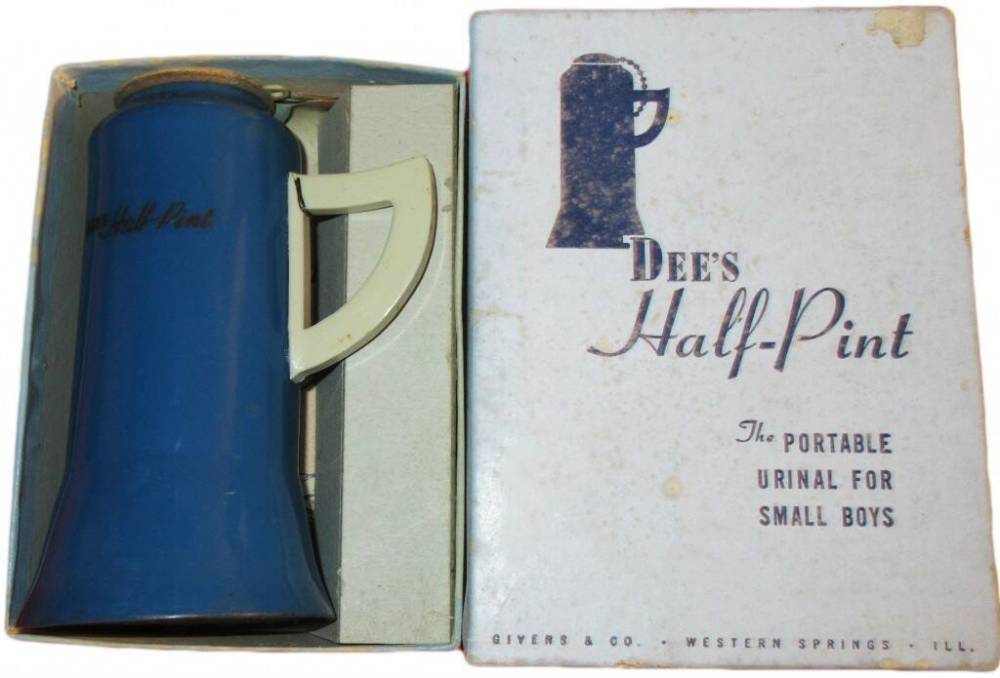Curious about commodes? Well, urine luck, as Brandon University history students have filled out the back stories of some of the HSC museum’s collection of bedpans
Read this article for free:
or
Already have an account? Log in here »
To continue reading, please subscribe:
Monthly Digital Subscription
$1 per week for 24 weeks*
- Enjoy unlimited reading on winnipegfreepress.com
- Read the E-Edition, our digital replica newspaper
- Access News Break, our award-winning app
- Play interactive puzzles
*Billed as $4.00 plus GST every four weeks. After 24 weeks, price increases to the regular rate of $19.00 plus GST every four weeks. Offer available to new and qualified returning subscribers only. Cancel any time.
Monthly Digital Subscription
$4.75/week*
- Enjoy unlimited reading on winnipegfreepress.com
- Read the E-Edition, our digital replica newspaper
- Access News Break, our award-winning app
- Play interactive puzzles
*Billed as $19 plus GST every four weeks. Cancel any time.
To continue reading, please subscribe:
Add Free Press access to your Brandon Sun subscription for only an additional
$1 for the first 4 weeks*
*Your next subscription payment will increase by $1.00 and you will be charged $16.99 plus GST for four weeks. After four weeks, your payment will increase to $23.99 plus GST every four weeks.
Read unlimited articles for free today:
or
Already have an account? Log in here »
Hey there, time traveller!
This article was published 15/12/2023 (666 days ago), so information in it may no longer be current.
Emma Prescott was sitting on a problem.
As curator of the Health Sciences Centre’s HSC Archives/Museum, Prescott had long been fascinated by a small collection of bedpans she inherited, when she started at the by-appointment-only gallery in 2010.
Every now and again, she would exhibit all eight within the hospital. That included a couple of occasions during the holiday season, when she teasingly adorned the lot with tinsel and garland, and situated them in a public cafeteria for patients and visitors alike to peruse.
Unfortunately, there was little to no background information pertaining to the individual specimens. That meant if viewers were curious how old this or that commode was, or what its link to HSC may have been, she was unable to provide them with an answer.
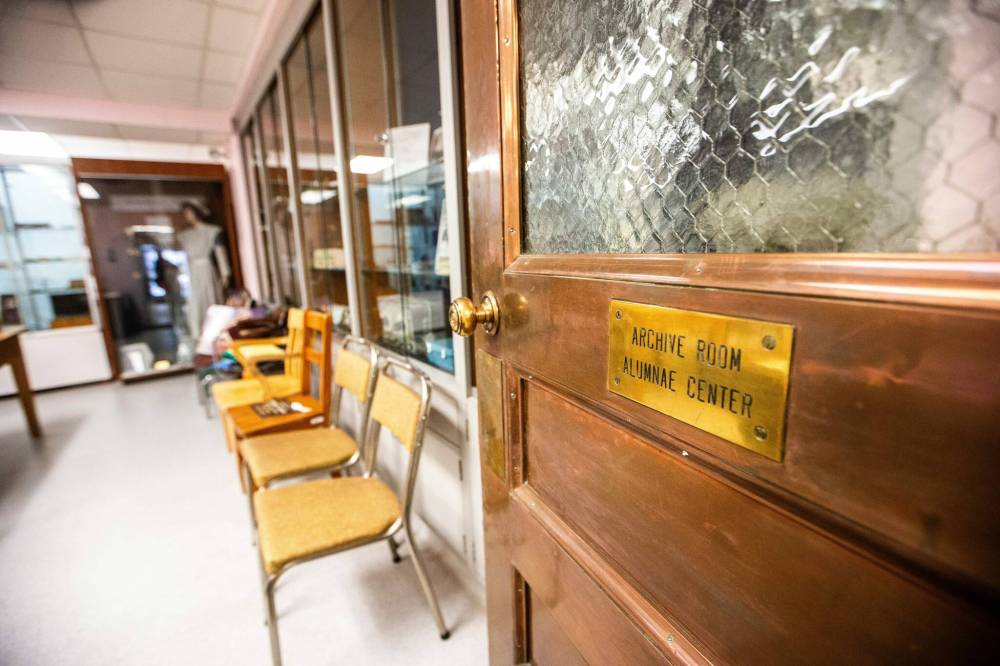
Given that set of circumstances, imagine Prescott’s surprise in August, when she opened her email and came across a message from the Association of Manitoba Museums. The forwarded note indicated that Brandon University professor Rhonda Hinther was polling museums in the province, to see if any held pieces of intrigue her public history class could research during first semester, in exchange for course credit.
Prescott was initially hesitant to respond. She guessed most would pooh-pooh the notion of probing such a utilitarian object. But after rereading Hinther’s missive, which mentioned students would have access to multiple databases to assist them in their sleuthing, she threw the bedpans in the ring, to see if there were any takers.
“I told myself I’d be pleased if even one of the bedpans was claimed, so I was obviously overjoyed when I learned seven students had signed on,” Prescott says, seated at her desk, across from a glass display case housing the bedpans, along with an assortment of other medical artifacts dating back to when the Winnipeg General Hospital, HSC’s predecessor, was founded in 1872.
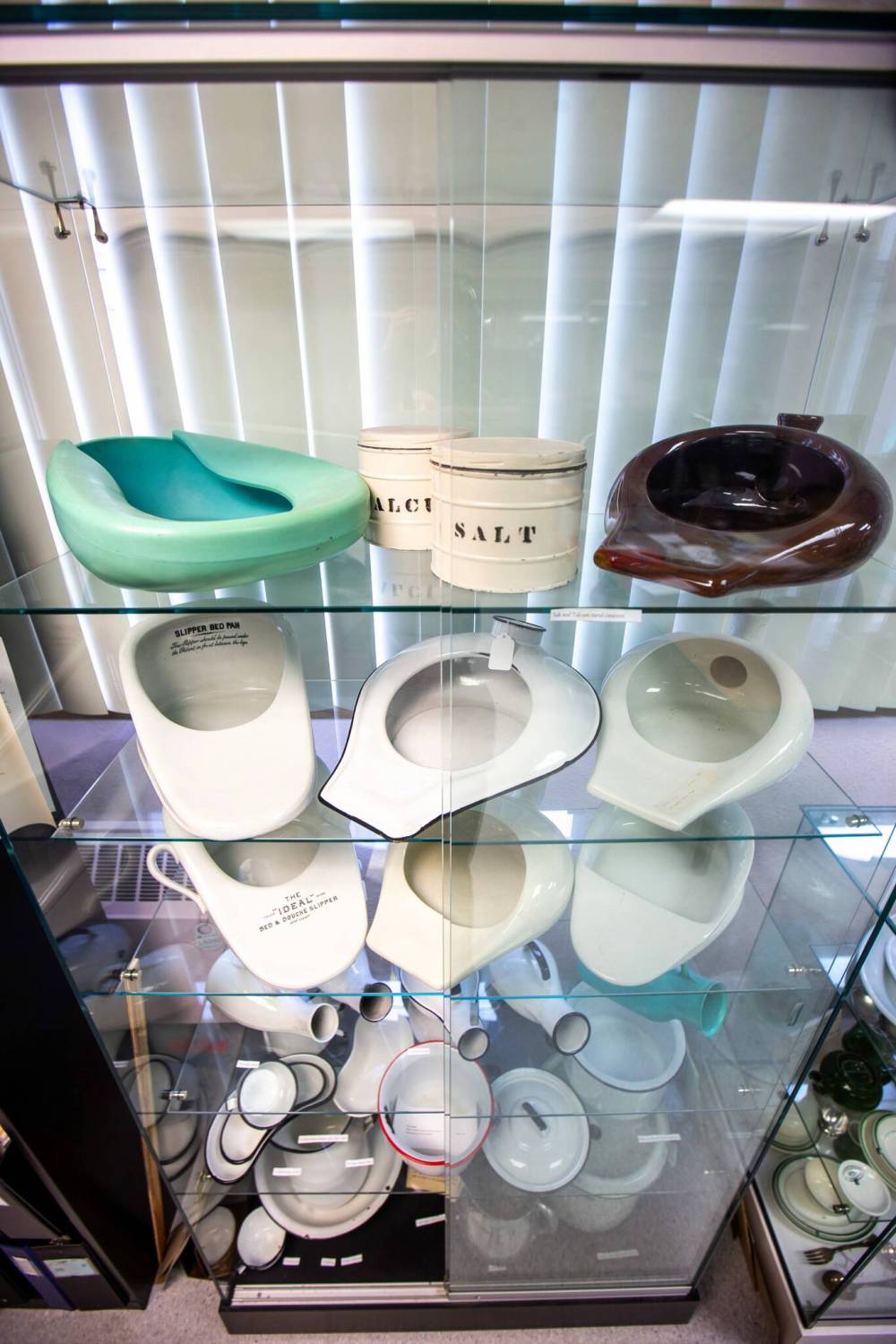
Reached at work, Hinther says it was left to Prescott to divide the bedpans up among the students, and to send them dimensions and the type of material each was fashioned from, along with photographs taken from various angles.
“Because there was next to nothing to go on, it was clearly going to be a challenge for the students,” Hinther says, noting of all the subject matter students have scrutinized since the course was introduced in 2015 — from board games to fishing gear to beauty pageant memorabilia — bedpans are definitely up there, in terms of uniqueness.
“Even if their bedpan proved impossible to trace precisely, they still tried their best by coming up with a timeline of bedpans in general, or by comparing it to what was in other hospitals’ collections.” (Wait! What? HSC isn’t the only place hanging onto old bedpans?)
Dayna Lytwyn is in her third year at Brandon University, where she is majoring in history, and minoring in anthropology and Indigenous studies.
She laughs, saying she believes she got off lucky, as the green bedpan she was entrusted with was made out of plastic.
That gave her a starting point, she felt, given manufacturers’ large-scale use of plastic didn’t kick in until the early 1950s. More importantly, hers carried a faint stamp on the bottom, which, following careful analysis, she was able to make out as “Vollrath.”
Lytwyn reached out to a Wisconsin-based company called Vollrath Foodservices, to see if they were connected in any way and if so, could they help her fill in a few blanks. A representative got back to her almost immediately, which she attributes to her line of questioning probably being more grabbing than what generally pops up in a “contact us” box.
“They told me they used to make bedpans, but stopped producing them around 1977. Also, based on what I shared with them, they figured my bedpan was probably from 1976, or shortly before that,” she says.
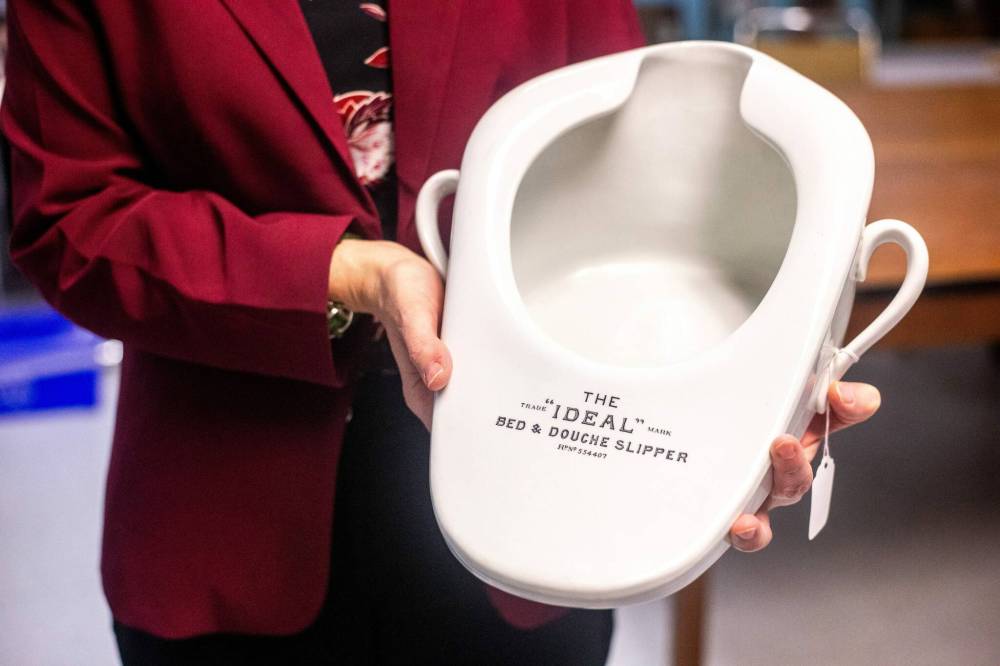
Still, how it found its way to HSC remained anybody’s guess.
Lytwyn read that while the vast majority of bedpans are used in a hospital setting, there was a period when they, along with chamber pots, were considered almost a household essential, especially in remote, northern regions where a frigid January trip to the outhouse wasn’t exactly No. 1 — or No. 2 — on anybody’s list.
“So yeah, it could have been donated by a hospital in the province, but it could have come from a private residence, too,” she says, adding there were definitely evenings at her part-time job, when her co-workers jokingly said, “Uh, Dayna, you’re talking about bedpans, again.”
Kaitlyn Perrett, a third-year education student at BU majoring in history, admits to having “zero, zip” knowledge of bedpans ahead of the assignment, aside from being aware of their intended use.
Unlike Lytwyn’s, her bedpan, brown in colour and made out of porcelain, didn’t boast anything akin to a firm’s insignia.
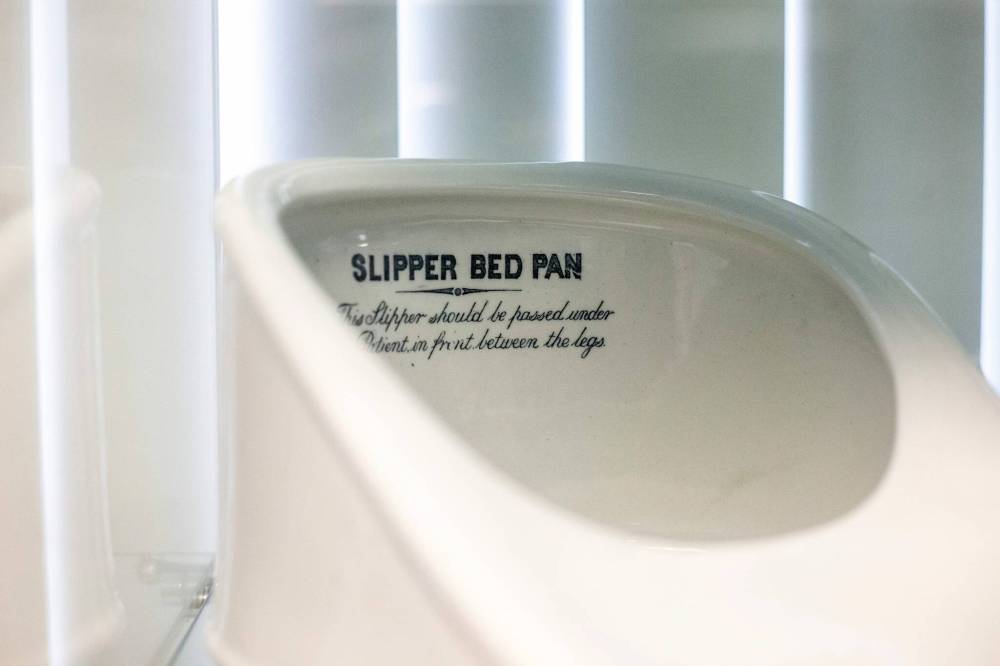
Rather, the lone clue as to the bedpan’s origin was a faded handwritten name on the underside, “Mrs. Westmacott,” followed by a note indicating said person graduated — no word from what or where — in 1945.
At first, Perrett wasn’t sure what the date referred to. Surely, the bedpan couldn’t have been somebody’s idea of a grad present?
Only after delving further did she learn that public health nurses from that era ordinarily kept a bedpan in their possession, to bring along to house calls. She concluded that must have been the situation, in this one’s case.
“Other than that, I didn’t come up with too much,” she says. “After all, porcelain had been around for a long time before 1945, so it was impossible to pinpoint exactly when my bedpan was made.”
Owing to that, she started hunting around for bedpan-related trivia to help flesh out her 3,000-word essay.
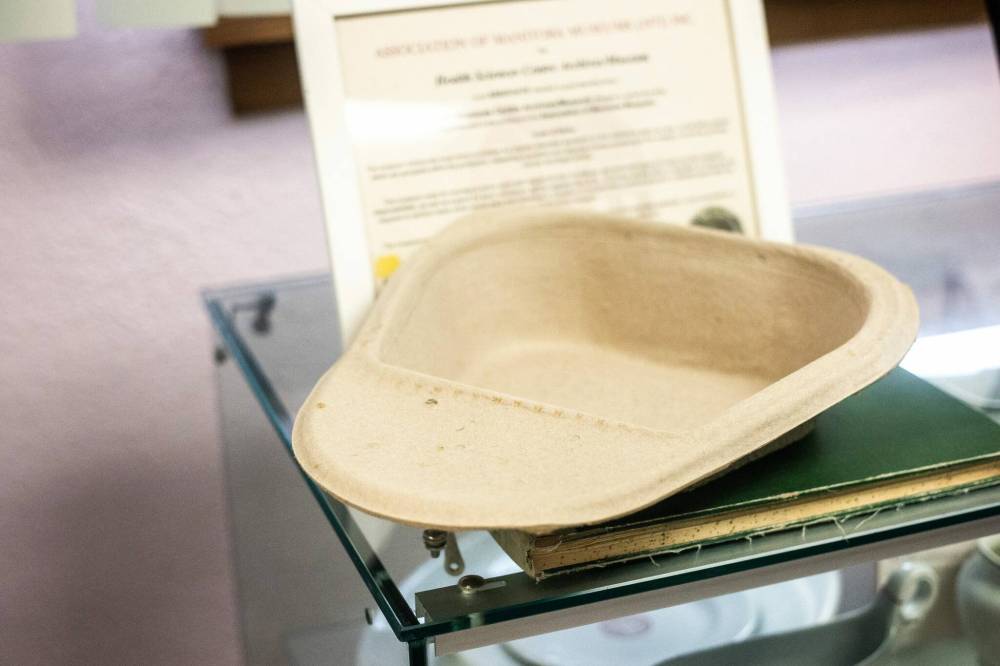
That took her to a news article about a bedpan that once belonged to American president George Washington. Apparently, it had been sold at auction to a person who didn’t recognize what it was, and had reportedly used it in the kitchen, to boil water.
“I also brought the topic up with my grandparents, to see if they had any personal experience,” says Perrett, who hasn’t ruled out visiting “her” bedpan in person at HSC, when she returns home to St. Andrews, during Christmas break.
“My grandpa said he remembered people with more money having a bedpan in the house, which to me seemed kind of ironic.”
Not necessarily, says Eric Eakin, an Ohio resident who is believed to have the largest personal collection of bedpans — some 260 and counting — on the planet.
Tucked in among his many treasures is what at first glance appears to be a ceramic water bottle, yet is in fact a portable urinal.
Ohio resident Eric Eakin is believed to have the world’s largest collection of bedpans — 260 and counting.People from all walks of life, rich or poor, would have kept something similar in their vehicle “back in the day,” for those times when they suddenly felt the urge, while barrelling along the highway, Eakin says over the phone from his home in Bay Village, a suburb of Cleveland.
The 71-year-old retiree credits his late mother for his rather quirky predilection.
“It began in 1963, when she was visiting friends in the U.K.,” he says. “On the day she was leaving, they gave her a ceramic bedpan as a gag gift, that she had to lug onto the plane and cross the Atlantic with.”
The bedpan may have been intended as a joke, yet she kept it regardless, in addition to a matching version she turned up a few years later, at a secondhand store.
Eakin laid claim to both bedpans following his mother’s death. Being a curious sort, he started to watch for other bedpans, whenever he and his wife went thrifting.
Ohio resident Eric Eakin's collection includes a portable urinal that might be mistaken for a water bottle.Faster than you can say “which way to the men’s room?” he was bringing home examples of every size and description, including a metal one he was able to trace to a 1950s-era B-52 bomber and another that, for whatever reason, came attached to the neck of a six-string guitar.
“I do have shelving, but I’ve kind of run out of linear space, so a lot of them are currently stacked one on top of the other, down in the basement,” he says, when he is asked how he shows off his bedpans, which he hopes to donate to a museum down the line, since none of his children seem to, ahem, give a crap about his cache.
“You know that old saying about being so poor you don’t have a pot to pee in? Let’s just say that’s never going to be me,” he deadpans.
Back at Brandon University, Hinther says she definitely gained an entirely new appreciation for the humble mobility aids, as she was grading papers.
“Maybe it’s a cliché of being an instructor, but it’s often said you learn more from your students than what you’re teaching them in the first place,” she says, noting she has been in touch with Prescott, and is hopeful HSC will be able to include the class’s findings the next time the bedpans are out and about.
“I’m not going to lie,” Hinther goes on. “I never gave bedpans a second thought before all this but thanks to everybody’s hard work, I can safely say I now know more about bedpans than I previously thought possible.”
david.sanderson@freepress.mb.ca
Dave Sanderson was born in Regina but please, don’t hold that against him.
Our newsroom depends on a growing audience of readers to power our journalism. If you are not a paid reader, please consider becoming a subscriber.
Our newsroom depends on its audience of readers to power our journalism. Thank you for your support.

